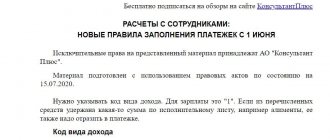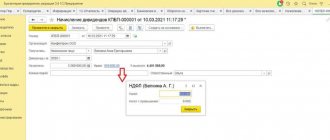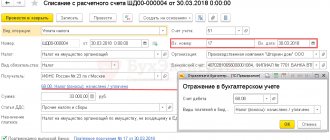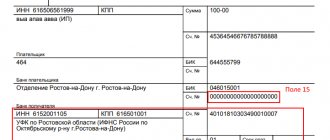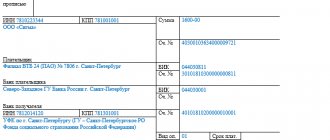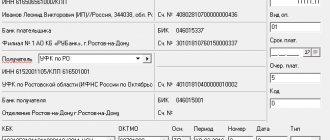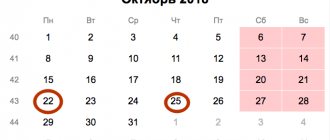Taxpayers have the opportunity to independently generate payment documents (payment orders) in the interactive services of the Federal Tax Service of Russia.
Thus, a payment order can be generated using the following services:
- “Taxpayer’s personal account”;
- "Pay your taxes";
- “Fill out the payment order.”
The “Pay Taxes” service was created as an entry point from which you can follow a link to all services of the official website of the Federal Tax Service of Russia, which allow you to generate a payment document and make payment online through one of the partner banks that have entered into an agreement with the Federal Tax Service of Russia.
Filling out a payment order in 2020-2021
When filling out a payment order, you should be guided by:
- regulation No. 383-P;
- Order of the Ministry of Finance of Russia “On approval of the Rules for indicating information in the details of orders for the transfer of funds for payment of payments to the budgetary system of the Russian Federation” dated November 12, 2013 No. 107n - when drawing up payments for taxes, fees and contributions.
Note! Since 2021, there have been changes in the details of tax payments.
Let's present a short step-by-step instruction. In this case, we will focus on filling out the details of a paper order, although at present few people make payments simply on a form. As a rule, special accounting programs are used for this, and for electronic payments, software of the “Bank-Client” type is used.
Step 1. Indicate the number and date of the payment.
Payment orders are numbered in chronological order. The number must be non-zero and contain no more than 6 characters. The date in a paper document is given in the format DD.MM.YYYY. In an electronic order, the date is filled in in the format established by the bank.
Step 2. Specify the type of payment.
It can have the meaning “Urgent”, “Telegraph”, “Mail”. A different value or its absence is possible if such a filling procedure is established by the bank. In an electronic payment, the value is indicated in the form of a code established by the bank.
Step 3. Payer status.
It is indicated in field 101, but only for payments to the budget. The list of status codes is given in Appendix 5 to the order of the Ministry of Finance of Russia dated November 12, 2013 No. 107n. The typical payer may find the following useful:
- 01 - taxpayer (payer of fees) - legal entity;
- 02 - tax agent;
- 06 - participant in foreign economic activity - legal entity;
- 08 - payer - a legal entity (individual entrepreneur) transferring funds for payment of insurance premiums and other payments to the budget system of the Russian Federation;
- 09 - taxpayer (payer of fees) - individual entrepreneur;
- 10 - taxpayer (payer of fees) - a notary engaged in private practice;
- 11 - taxpayer (payer of fees) - lawyer who established a law office;
- 12 - taxpayer (payer of fees) - head of a peasant (farm) enterprise;
- 13 - taxpayer (payer of fees) - another individual (bank client (account holder));
- 14 - taxpayer making payments to individuals;
- 16 - participant in foreign economic activity - an individual;
- 17 - participant in foreign economic activity - individual entrepreneur;
- 18 - a payer of customs duties who is not a declarant, who is obligated by the legislation of the Russian Federation to pay customs duties;
- 19 - organizations and their branches (hereinafter referred to as organizations) that have drawn up an order for the transfer of funds withheld from the wages (income) of a debtor - an individual to repay arrears in payments to the budget system of the Russian Federation on the basis of an executive document sent to the organization in in the prescribed manner;
- 21 - responsible participant in the consolidated group of taxpayers;
- 22 - participant of a consolidated group of taxpayers;
- 24 - payer - an individual who transfers funds to pay insurance premiums and other payments to the budget system of the Russian Federation;
- 25 - guarantor banks that have drawn up an order for the transfer of funds to the budget system of the Russian Federation upon the return of the amount of value added tax excessively received by the taxpayer (credited to him), in a declarative manner, as well as upon payment of excise taxes calculated on transactions of sale of excisable goods for limits of the territory of the Russian Federation, and excise taxes on alcohol and (or) excisable alcohol-containing products;
- 26 - founders (participants) of the debtor, owners of the property of the debtor - a unitary enterprise or third parties who have drawn up an order for the transfer of funds to repay claims against the debtor for the payment of mandatory payments included in the register of creditors' claims, during the procedures applied in a bankruptcy case;
- 27 - credit organizations or their branches that have drawn up an order for the transfer of funds transferred from the budget system of the Russian Federation, not credited to the recipient and subject to return to the budget system of the Russian Federation;
- 28 - participant in foreign economic activity - recipient of international mail.
Read more about payer status in this material.
Step 4. Specify the payment amount.
The amount of the paid amount in the payment order is given in numbers and words.
The amount in words is indicated from the beginning of the line with a capital letter - in rubles and kopecks (kopecks are written in numbers). In this case, the words “ruble” and “kopeck” are written in full, without abbreviation. If the amount is in whole rubles, then kopecks may not be indicated.
In the amount of numbers, rubles are separated from kopecks by a “–” sign. If the payment is without kopecks, put an “=” sign after the rubles.
For example:
- the amount in words “Twelve thousand three hundred forty-five rubles fifty kopecks”, in numbers “12 345–50”;
- or the amount in words “Ten thousand rubles”, in numbers “10,000=”.
In the electronic order, the payment amount is indicated in numbers in the format established by the bank.
Step 5. Fill in the payer's details.
This:
- TIN and checkpoint;
- name or full name, if you are an individual entrepreneur or other self-employed person;
- bank details: account number, name of the bank, its BIC and correspondent account.
As a rule, the details are already entered into the program, so you don’t have to fill them out. At the same time, if you, for example, have several current accounts, make sure to indicate the one from which you were going to transfer money.
Step 6. Fill in the recipient's details.
They are the same as those of the payer:
- TIN and checkpoint;
- Name;
- account details.
If a payment order for the payment of taxes is filled out, then the corresponding UFK is indicated as the recipient, and next to it in brackets is the name of the revenue administrator (inspectorate or fund). Payment details can be obtained from the Federal Tax Service or the fund.
If the payment is not tax, the payment details are taken, for example, from the contract or invoice for payment.
Step 7. We provide additional codes and ciphers.
This is the table below the payee's bank details. It always indicates:
- Type of operation. The payment order is assigned code 01.
- Code purpose of payment (“Name of pl.”)
From 06/01/2020, the code for the type of income is entered here when making payments to employees. Find out what value to enter in this field in ConsultantPlus. To do everything correctly, get trial access to the system and go to the Review material. It's free.
- Sequence of payment. Payments to counterparties and for self-payment of taxes, fees, and contributions have the 5th priority.
- Code. For current tax and non-tax payments, you need to enter 0. If the payment is made according to a document that has a UIP (unique payment identifier), a 20-digit UIP code is entered.
Step 8. Specify payment information.
If the payment is not tax, everything is simple. In field 24 you must indicate the basis on which the payment is made. This may be the number of the contract, account, etc. Information about VAT (rate, tax amount) is also provided here or a note is made: “VAT is not subject to.”
See also the article “Indicate the purpose of payment correctly in the payment order.”
In tax payments, you additionally need to fill out a number of cells above field 24.
First of all, the BCC is reflected in accordance with the order of the Ministry of Finance on the approval of codes for the corresponding year.
Read about the currently used BCCs in this article.
Next comes the OKTMO code in accordance with the All-Russian Classifier of Municipal Territories (approved by order of Rosstandart dated June 14, 2013 No. 159-ST). It must match the OKTMO in the declaration for the relevant tax.
The next cell indicates the two-digit code of the payment basis. The main codes are as follows:
- TP - payments of the current year;
- ZD - voluntary repayment of debt for expired tax, settlement (reporting) periods in the absence of a requirement from the tax authority to pay taxes (fees);
- TR - repayment of debt at the request of the tax authority to pay taxes (fees);
- AP - repayment of debt according to the inspection report.
The next field is the tax period. The format XX.XX.XXXX indicates either the frequency of payment of the tax payment or the specific date of its payment. The frequency can be monthly (MS), quarterly (QU), semi-annually (SL) or annual (YA).
Samples of filling out the tax period indicator:
MS.02.2021; KV.01.2021; PL.02.2021; GD.00.2020; 02/04/2021.
This is followed by cells for the number and date of the document that is the basis for the payment. For current tax payments, enter 0 in the number, and indicate the date of signing the declaration (calculation) as the date.
Field 110 “Payment type” is not filled in.
Step 9. Sign the payment order.
The paper payment must be signed by the person whose signature is on the bank card. The electronic order is signed by the person who owns the signature key. If there is a seal, it is affixed to a paper copy.
See also “Basic details of a payment order”.
If you have access to ConsultantPlus, check whether you have filled out payments for taxes and contributions correctly. If you don't have access, get a free trial of online legal access.
How to apply for a salary payment on a card - Moneyprofy.ru
A payment order for a salary advance - a sample of it, drawn up taking into account current legal requirements, can be found below. Such a payment order is not difficult to fill out, but it still has a number of noteworthy nuances, which we invite you to familiarize yourself with in this article.
What are the features of advance payment?
Salary according to the employment contract, according to Art. 136 of the Labor Code of the Russian Federation, must be paid at least once every half month. More often it is not forbidden to pay remuneration for work, but still employers usually divide the salary into 2 parts:
- the amount paid based on the results of work for the 1st half of the billing month (it is “unofficially” called an advance, although such a term is not mentioned in the Labor Code of the Russian Federation);
- the main part paid based on the results of work for the 2nd half of the billing month.
You can learn more about the legal requirements for setting the deadline for paying wages in the article “How wages are paid - procedure and verification.”
If the salary is paid through a bank account, the payment slip in both of the above cases is filled out almost identically. The only difference is in filling out the details “Purpose of payment”: when transferring the advance, you need to provide wording reflecting the fact that the salary is transferred specifically for the 1st half of the month.
Let's consider exactly how this wording will sound and how other important payment details are filled out.
What is the procedure for filling out an advance payment form?
From the point of view of ensuring the passage of the advance payment, the following key payment details can be identified:
- Field “Payment recipient”: the name of the financial institution where the employee’s salary account is opened is indicated here.
- Detail “Payment amount”: reflects the advance amount according to statement T-51 (or similar), which is compiled for the 1st half of the month.
- Field “Purpose of payment”: indicate the wording “Payment of wages for half of such and such a month” indicating the number and date of the salary slip.
- Details “Payment recipient”: indicate full name. employee.
- “Payment recipient account” detail: the employee’s personal account number in a financial institution is reflected.
You can download a sample payment order for salary advance on our website.
The payment for a salary advance is drawn up in almost the same way as for the transfer of the final part of the salary - with one difference: in the details “Purpose of payment” it is indicated that the salary is being transferred for the 1st half of the month and information about the payroll for the billing period is provided.
You can learn more about the features of filling out other payments in the articles:
Be the first to know about important tax changes
Have questions? Get quick answers on our forum!
nalog-nalog.ru
Related publications
Labor legislation establishes the employer’s obligation to pay employees wages at least once every six months. The usual gradation for advance payment and payment. The payment deadlines are (Article 136 of the Labor Code of the Russian Federation):
- 30th day of the current month – for advance payment for the 1st half of the month;
- The 15th day of the next month is for monthly calculations.
Full compliance with these deadlines also applies to salaries transferred to the card, if the company practices issuing salaries not through a traditional cash register, but by bank transfer to staff cards.
Payment order for salary to card
The transfer is executed by payment order, the details of filling which are discussed in our publication.
It is important to take into account the fact that the payment day is usually considered the day the funds are credited to the card, and this day should not be later than the deadlines established by tax legislation.
In order to prevent delays in salary payments, it is necessary to take into account the time period that the bank allocates for crediting money to accounts.
A payment order for the transfer of salaries to staff is a document whose execution is not difficult, but it is worth taking into account the nuances of filling out the details. To ensure normal payment processing, they are filled out in accordance with the following requirements:
- in the “Payment recipient” field indicate the bank institution that has the company’s salary project under the concluded agreement and the account number to which the transfer is made;
- in the “Payment amount” column, the transfer amount is recorded, which is similar to the calculated amount to be issued in person in the company’s accounting records - an advance payment or final payment for the month;
- in the “Purpose of payment” field they must reflect for what period the transfer is being made. For example, when transferring an advance, it is formulated as follows: “Payment of wages for the 1st half of the month according to register No. _ dated _._.2021.” A mandatory attachment to the payment order for the transfer of salary amounts is a register indicating the payments due to each employee of the company.
Sample payment slip for transferring salary to a card:
Payment order to an individual’s card
If the payment is drawn up for the transfer of an amount due to one employee, then it is filled out a little differently:
- the purpose of the payment is specific - in this field indicate the employee’s full name, a note about the nature of the payment (for example, “payment of wages for June 2021 to Alexander Mikhailovich Rebrov), his personal account number and amount;
- in the payee column reflect the full name of the employee;
- in the “Recipient's account” field indicate the employee’s account number at the bank institution.
An example of filling out a payment order to a Sberbank card when transferring money to an individual employee:
You can transfer not only your salary to your employee’s card, but also all payments that he receives while performing his job duties. For example, accountable amounts when going on a business trip or for business needs. At the same time, the payment order reflects the purpose of the payment “to the account on the card” , indicating the employee’s personal account number.
spmag.ru
Introductory information about transferring salaries to the card
All employers are required to pay their employees wages at least every half month. Salaries must be paid no later than the 15th day after the end of the period for which they were accrued.
That is, the deadline for the advance payment is the 30th day of the current month, and for salaries - the 15th day of the next month (Part 6 of Article 136 of the Labor Code of the Russian Federation). This fully applies to wages transferred to the card.
Transfer salaries to employees' bank accounts at least every six months (Part 6, Article 136 of the Labor Code of the Russian Federation).
The employee must write an application for the transfer of his salary to the card. The application indicates the employee's bank account number. The employee has the right to choose the bank to transfer his salary. He must notify the employer of this in writing no later than five working days before payment of wages. This is stated in Part 3 of Article 136 of the Labor Code of the Russian Federation.
What is considered a “pay day”
What is correct to consider as the day of salary payment when transferring funds to a card? Day of transfer of funds from the current account of an organization or individual entrepreneur? Or the date when the money arrived on the employee’s card? In our opinion, the day of payment of wages by bank transfer should be considered the date of receipt of funds on the employee’s bank card. After all, after the money has been received, the employee can dispose of it at his own discretion.
What to send to the bank
In order to transfer salaries to the bank accounts of several employees in 2021, the employer must transfer to the bank:
- register for transferring funds to employees;
- payment document (payment order).
Payment orders for transferring wages to a card can be submitted to the bank either “on paper” or electronically.
How to fill out a payment form
Let us explain what to indicate in some fields of the payment order for the transfer of wages to the cards of several employees:
- in the “Recipient” field – the name and location of the bank in which the employees’ accounts are opened (for example, Sberbank);
- in the “Amount” field – the total amount that needs to be transferred to the employees’ accounts;
- in the “Purpose of payment” field – the purpose of the payment and make a reference to the date and register number (for example: “Transfer of wages for January 2021 according to register No. 6 dated February 05, 2021”).
Here is a sample payment order for salary transfers to a card in 2021 based on the register:
If the salary is transferred to the account of one employee, then indicate in the payment order:
- in the “Recipient” field – the employee’s last name, first name, patronymic;
- in the “Recipient's Account” field – the number of his personal bank account.
Here is an example of a payment order for transferring wages to a card in 2021 for one individual:
, please select a piece of text and press Ctrl+Enter.
Source: //moneyprofy.ru/kak-oformit-platezhku-na-zarplatu-na-k/
Example of filling out a payment order in 2020-2021: sample
Let's show a sample of filling out a payment order using a conditional example.
Let's say the organization ICS LLC needs to pay personal income tax for January 2021 in the amount of 22,340 rubles.
About the deadlines established for paying personal income tax on wages, read the material “When to transfer income tax from wages?” .
The specific features of the order will be:
- payer status - code 02, since the payer organization is a tax agent;
- KBK for personal income tax - 18210102010011000110;
- the basis of the payment is the TP code, since this is a payment of the current period;
- The frequency of payment is MS.01.2021, since this is a payment for January 2021.
You can fill out the payment order - 2021 on our website.
New requirements for payments from 2021
Starting from the new year, several details in the tax bill will change at once (letter of the Federal Tax Service No. KCH-4-8/16504 dated 10/08/2020):
- in field 13 “Recipient's bank” after the name of the bank, the name of the corresponding Treasury account should be indicated (through the sign “//”);
- new values will be indicated in field 14 “BIC”;
- in the previously unfilled field 15 “Account No.” the recipient’s bank account number is entered;
- in field 17 “Account No.” indicate the recipient’s new accounts.
In the attachment to the Federal Tax Service letter No. KCH-4-8/16504 you can find new details of all territorial bodies of the Federal Treasury, indicating the fields of the payment order in which they are entered. Until May 1, 2021, a so-called “transition period” is established, during which taxpayers are still allowed to use both new and old accounts, but it is better to indicate current details as early as January 1, 2021.
Results
The fields of the payment order can be filled in partially or completely depending on the type of payment (regular or tax).
Field 22 “Code” can take the value 0 or be filled in if the payment identifier is known. For tax payments, fields 104–109 are additionally filled in in the payment order. You can find more complete information on the topic in ConsultantPlus. Free trial access to the system for 2 days.
What changes came into force earlier: from January 1, 2021
From January 1, 2021, a change is provided for individual payers who are not individual entrepreneurs. Order of the Ministry of Finance dated September 14, 2021 No. 199n updated the rules approved by Order of the Ministry of Finance dated November 12, 2013 No. 107n.
Previously, in order for inspectors to be able to determine who the payment came from, an individual had to indicate his TIN. Instead of the TIN, you could fill out field 108 “Number of the document that is the basis for the payment”, or enter the UIN in field 22 “Code” (in the absence of a UIN, it was possible to indicate the address of residence or stay).
Now, if you do not have a TIN and UIN, you can indicate the series and number of your passport or SNILS.
